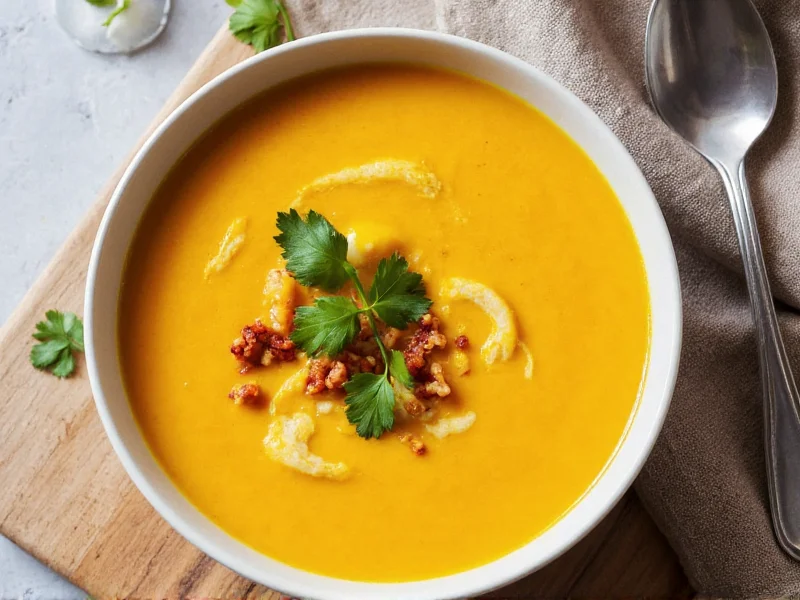The Essential Butternut Curry Soup Formula
Creating exceptional butternut curry soup starts with understanding the flavor foundation. The magic happens when roasted butternut squash meets a carefully balanced spice blend. Unlike ordinary pureed soups, the best butternut squash curry soup recipes incorporate multiple cooking techniques—roasting for depth, sautéing for aroma, and simmering for flavor integration.
Core Ingredients and Their Purpose
Each component serves a specific function in developing complex flavors:
| Ingredient | Function | Substitution Options |
|---|---|---|
| Butternut squash (2 lbs) | Provides natural sweetness and creamy texture | Pumpkin, sweet potato |
| Coconut milk (1 can) | Creates richness without dairy | Cashew cream, Greek yogurt |
| Yellow curry paste (2 tbsp) | Flavor base with balanced heat | Red curry paste, garam masala |
| Fresh ginger (1" piece) | Adds bright, warming notes | Ginger powder (1 tsp) |
| Vegetable broth (4 cups) | Forms the soup base | Chicken broth, water + bouillon |
Step-by-Step Preparation Guide
Follow this professional technique for restaurant-quality results:
- Roast the squash at 400°F (200°C) for 25 minutes—this caramelizes natural sugars and deepens flavor far beyond boiling
- Sauté aromatics including onions, garlic, and ginger until translucent but not browned
- Bloom spices by adding curry paste and dry spices to the oil for 60 seconds to release essential oils
- Combine and simmer roasted squash with broth for 15 minutes to meld flavors
- Blend until smooth using an immersion blender for safest results
- Finish with coconut milk and adjust seasoning just before serving
Proven Flavor Enhancements
Elevate your easy butternut squash curry soup with these chef-tested additions:
- Add 1/2 apple while roasting squash for subtle sweetness that complements curry spices
- Stir in 1 tsp lime zest at the end for bright contrast to rich flavors
- Include a splash of fish sauce (even in vegetarian versions) for umami depth
- Top with toasted coconut flakes for textural contrast
- Swirl with chili oil for visually appealing presentation
Variations for Different Dietary Needs
Adapt this versatile base recipe for various preferences:
Creamy Butternut Curry Soup Without Coconut Milk
Replace coconut milk with 1 cup raw cashews soaked in hot water for 20 minutes, then blended with 1 cup broth. This creates identical creaminess with a neutral flavor profile ideal for mild curry variations.
Spicy Butternut Curry Soup Version
Add 1 diced red chili with aromatics and increase curry paste to 3 tablespoons. For finishing, stir in 1 tablespoon tamarind paste to balance the heat with tangy complexity.
Butternut Squash and Apple Curry Soup
Roast 1 peeled, cored apple alongside the squash. After blending, stir in 1/4 cup apple cider and a pinch of cinnamon for a fall-inspired variation that works equally well as a healthy winter soup.
Serving Recommendations
Pair your homemade butternut curry soup with:
- Naan bread or crusty baguette for dipping
- Simple green salad with lemon vinaigrette
- Basmati rice for a more substantial meal
- Garnish with fresh cilantro and a dollop of plain yogurt
Storage and Reheating Instructions
This soup actually improves in flavor after 24 hours as spices continue to meld. Store in airtight containers:
- Refrigerator: Keeps for 4-5 days
- Freezer: Maintains quality for 3 months
- Reheating: Warm gently over medium-low heat, adding splashes of broth if needed
Nutritional Benefits
One serving (1.5 cups) of properly prepared butternut curry soup delivers:
- Over 200% of daily vitamin A needs from squash
- Significant vitamin C and potassium
- Healthy fats from coconut milk supporting nutrient absorption
- Only 220-280 calories per serving when prepared without added oil
- Natural anti-inflammatory compounds from curry spices
Troubleshooting Common Issues
Fix these frequent preparation problems:
- Too sweet: Balance with 1 tsp rice vinegar or lime juice
- Too spicy: Stir in additional coconut milk and a pinch of sugar
- Not creamy enough: Blend longer or add 1/4 cup cooked white beans
- Flat flavor: Add 1 tsp fish sauce or soy sauce for umami boost
Frequently Asked Questions
Can I make butternut curry soup without coconut milk?
Yes, you can create creamy butternut curry soup without coconut milk by using alternatives like cashew cream (soaked raw cashews blended with broth), silken tofu, or even white beans. For a lighter version, simply increase the vegetable broth and use an immersion blender to create natural creaminess from the butternut squash itself.
How do I prevent my butternut curry soup from being too sweet?
To balance excessive sweetness in butternut curry soup, add acidity with 1-2 teaspoons of rice vinegar, lime juice, or lemon juice. You can also incorporate savory elements like 1 teaspoon of fish sauce (even in vegetarian versions) or a pinch of smoked paprika. Properly blooming your curry spices in oil before adding liquids creates more complex flavors that naturally counterbalance sweetness.
What's the best way to store and reheat butternut curry soup?
Store cooled butternut curry soup in airtight containers for up to 5 days in the refrigerator or 3 months in the freezer. When reheating, warm gently over medium-low heat to preserve flavor integrity, adding small splashes of broth if the soup has thickened. Avoid boiling, which can cause coconut milk to separate. The soup often tastes even better the second day as flavors continue to meld.
Can I use canned butternut squash instead of fresh?
While fresh butternut squash delivers superior flavor and texture for homemade butternut curry soup, you can use canned pumpkin (not pumpkin pie filling) in a pinch. Use 2 cans (15 oz each) of pumpkin puree and increase roasting time for other vegetables to develop flavor depth. Note that canned pumpkin often contains added salt, so adjust seasoning carefully at the end of cooking.











 浙公网安备
33010002000092号
浙公网安备
33010002000092号 浙B2-20120091-4
浙B2-20120091-4